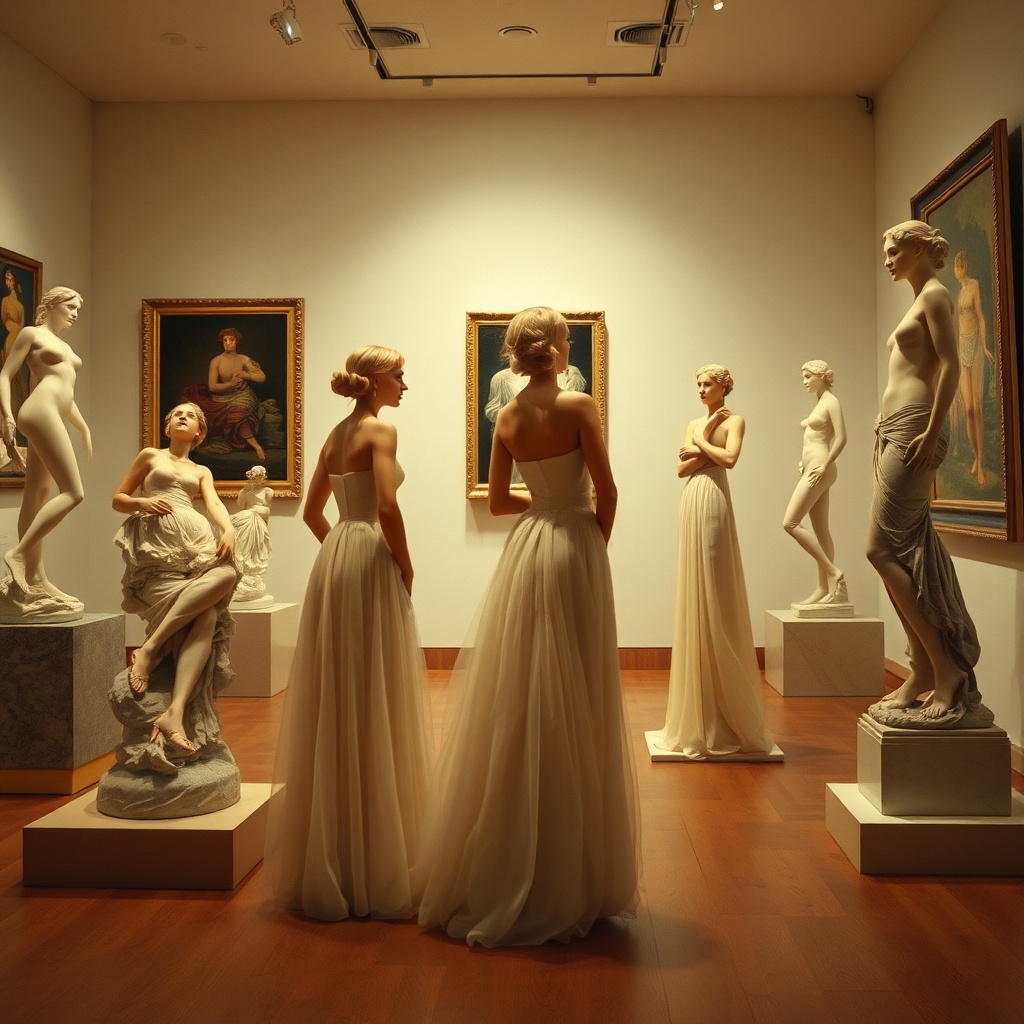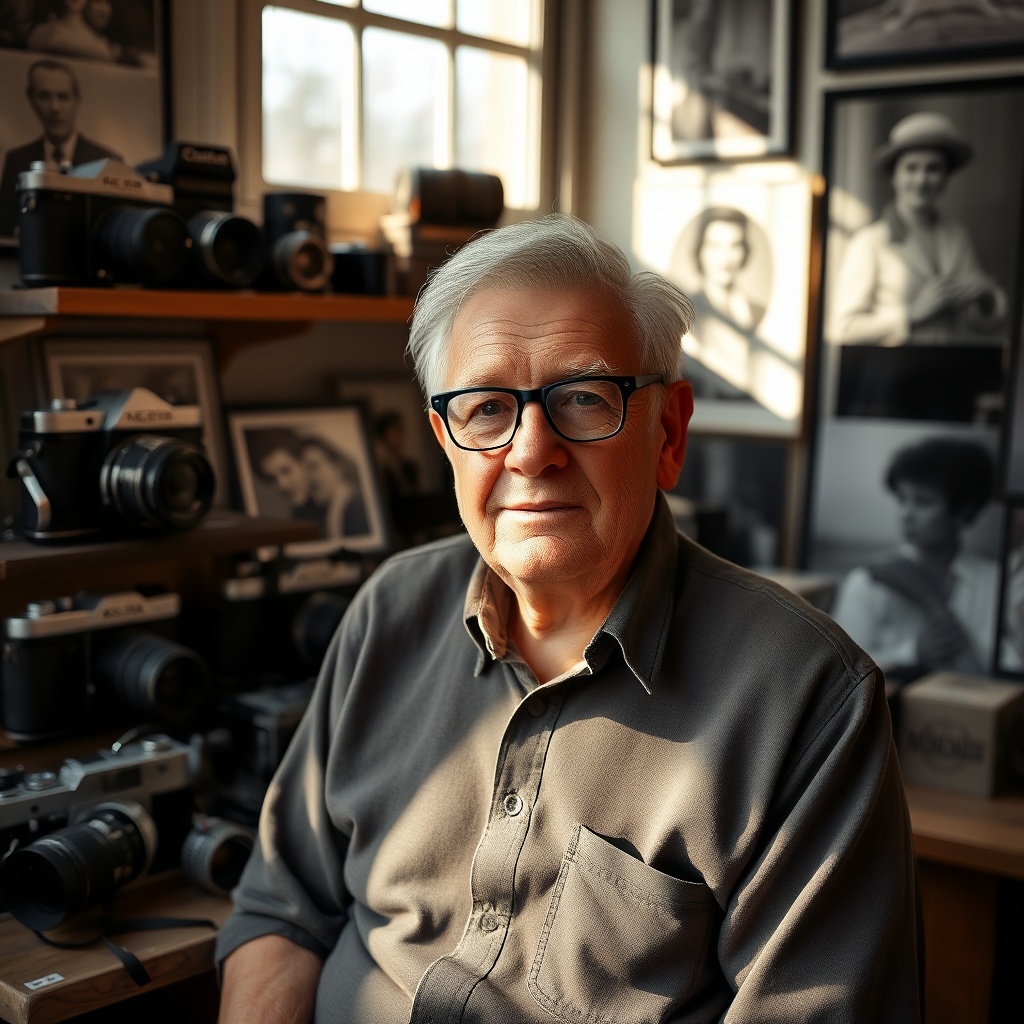Rediscovering the Grace: Iconic Poses of 1960s Nude Models

The 1960s was a decade of transformation, not just in culture and politics, but also in the realm of artistic expression. Among the most captivating subjects of this era were nude models, whose poses and forms became symbols of grace and beauty. In this article, we invite you to rediscover the iconic poses that defined a generation.
1. The Classic Recline
One of the most recognizable poses of the 1960s was the classic recline. Models would often be depicted lying gracefully, their bodies curving elegantly against the surface beneath them. This pose emphasized not only the natural lines of the body but also the play of light and shadow.
Key Characteristics:
- Soft curves that highlight femininity
- Use of drapery or minimal props
- Natural positioning of limbs
2. The Standing Silhouette
The standing silhouette was another iconic pose that showcased the model’s form in a striking way. Often captured in profile, these poses emphasized the model’s height and elegance. The standing pose was frequently used in fashion photography, symbolizing confidence and poise.
Key Characteristics:
- Defined posture with shoulders back
- Head held high, exuding confidence
- Subtle angling of the body to create depth
3. The Playful Twist
The playful twist was a pose that celebrated movement and spontaneity. Models would often be captured mid-action, turning their bodies in a way that suggested a dance-like quality. This pose conveyed a sense of joy and freedom, breaking traditional norms of stillness in nude modeling.
Key Characteristics:
- Dynamic positioning of limbs
- Expressive facial features
- A sense of motion captured in stillness
4. The Intimate Close-Up
Close-up photography allowed for an intimate exploration of the model’s features. In the 1960s, this style became popular as it highlighted the beauty of skin, the contours of the face, and the intricate details often overlooked in wider shots.
Key Characteristics:
- Focus on facial expressions
- Soft lighting to enhance features
- Capturing the essence of vulnerability
5. The Draped Elegance
Models often posed with fabric gracefully draped over their forms. This pose combined nudity with an element of mystery and sophistication, allowing the viewer to appreciate the artistry of both the human body and the textile.
Key Characteristics:
- Strategic placement of fabric
- Creating shapes and forms
- Invoking a sense of allure
The artistry of 1960s nude models continues to inspire and captivate audiences today. By rediscovering these iconic poses, we not only honor the legacy of these models but also celebrate the timeless elegance they embodied. Each pose tells a story, invites reflection, and encourages appreciation for the beauty of the human form.
The Feminine Form: Celebrating the Beauty and Strength of 1960s Artistry

In the vibrant decade of the 1960s, the art world witnessed a profound transformation, particularly in the portrayal of the feminine form. Nude models became not just subjects but symbols of beauty and strength, embodying a spirit of liberation and creativity. This exploration invites you to reflect on the artistry of this era and its significance.
The Cultural Context of the 1960s
The 1960s were marked by social upheaval and a quest for identity. Artists began to challenge traditional norms, leading to a renaissance in the representation of the human body. The feminine form was celebrated in various mediums, from painting to photography.
- Social Movements: The Women’s Liberation Movement encouraged a new appreciation for women’s strength and individuality.
- Artistic Innovation: Artists experimented with styles and techniques that emphasized the beauty of the human body.
Celebrating the Feminine Form
Artists of the 1960s portrayed the nude form in ways that highlighted both vulnerability and empowerment. This duality is crucial in understanding the artistic expressions of the time.
Key Artists and Their Contributions
| Artist | Style | Notable Works |
|---|---|---|
| Lucian Freud | Figurative | The Blue Door |
| Richard Avedon | Photography | In the American West |
| Henri Matisse | Fauvism | The Dance |
The Techniques Behind the Art
Understanding the techniques employed by artists of the 1960s reveals the depth of their work. These methods not only enhanced the aesthetic quality but also conveyed deeper meanings.
- Use of Color: Bold colors were often used to evoke emotion and highlight the form.
- Light and Shadow: Artists masterfully played with light to create depth and dimension.
- Composition: The arrangement of figures often told a story or conveyed a particular theme.
Impact on Modern Art
The legacy of 1960s nude artistry continues to influence contemporary art. Many modern artists draw inspiration from the techniques and themes established during this period.
The artistry of the 1960s remains a testament to the beauty and strength of the feminine form. By exploring this rich history, we can appreciate the courage of those who celebrated the human body as a work of art. As we reflect on this era, let us honor the timeless elegance that continues to inspire artists and audiences alike.
Behind the Lens: The Photographers Who Captured Timeless Elegance

Exploring the Golden Era of Photography
The 1960s were a pivotal decade in the world of photography, especially in the realm of nude art. Photographers during this time embraced a new freedom of expression, capturing the human form in ways that celebrated beauty and vulnerability. Are you ready to take a stroll down memory lane?
Icons of the Era
Among those who shaped this era were legendary photographers like Richard Avedon, Helmut Newton, and David Bailey. Each brought their unique perspective and style to the art of nude photography. Let’s delve into their contributions:
Richard Avedon: Known for his striking portraits, Avedon’s work often highlighted the personality of his subjects. Can you recall a photograph that made you feel an emotional connection?
Helmut Newton: Newton was famous for his provocative and sensual imagery. His photographs often blurred the lines between fashion and art. What emotions do you think his work evoked in viewers?
David Bailey: A leading figure in the Swinging Sixties, Bailey’s candid style and ability to capture raw emotion made his photographs memorable. Which of his works do you find most captivating?
The Techniques That Defined an Era
These photographers employed a range of techniques that contributed to their iconic status. From the use of dramatic lighting to innovative angles, they created images that were both timeless and bold. Can you imagine the excitement of being behind the scenes during one of these shoots?
Capturing the Essence of Femininity
Many of these artists had a profound understanding of femininity. They portrayed their models not merely as subjects but as muses who embodied strength and grace. How do you think this perspective influenced societal views on beauty during the 1960s?
Legacy and Influence
The work of these photographers laid the groundwork for future generations. Today, their images continue to inspire artists, fashion designers, and photographers alike. Can you think of contemporary photographers who echo their style or philosophy?
Reflection and Discussion
As we reflect on the artistry of the 1960s, consider how these images have shaped our understanding of beauty and self-expression. What memories or feelings do these black-and-white images evoke for you? Join the conversation and share your thoughts!
Cultural Shifts: How the 1960s Redefined Beauty Standards
Cultural Shifts in the 1960s
The 1960s were a decade of profound change, not just politically but also culturally. The emergence of new ideas about beauty and self-expression redefined the standards of the time. Can you recall the shifts that took place?
Beauty Standards Before the 1960s
Prior to the 1960s, beauty standards were often restrictive and dictated by societal norms. Women were expected to embody certain traits, such as:
| Trait | Description |
|---|---|
| Curvaceous Figures | Emphasis on hourglass shapes, often highlighted by corsets. |
| Subtle Makeup | Makeup was minimal and aimed at enhancing natural features. |
| Long Hair | Long hairstyles were considered the epitome of femininity. |
The Shift Begins
As the decade progressed, a radical shift occurred. The rise of the feminist movement and the sexual revolution challenged traditional views. This era celebrated individuality, and beauty began to be redefined. How do you feel about these changes?
New Icons of Beauty
Throughout the 1960s, several models and actresses emerged as new icons of beauty. They embraced a fresh take on physical appearance, leading to a broader acceptance of diverse body types and styles. Some of these icons included:
| Name | Contribution |
|---|---|
| Twiggy | Popularized the “boyish” look with her thin frame and short hair. |
| Jean Shrimpton | Known for her free-spirited style and natural beauty. |
| Cheryl Tiegs | Embraced the shift towards more athletic and toned body types. |
The Influence of Art and Photography
The art world played a significant role in redefining beauty standards. Photographers began to explore the nude form as a subject, celebrating the human body in a more artistic and less objectifying manner. This approach emphasized:
Naturalism: Highlighting the beauty of the human form without excessive retouching.
Artistic Expression: Models were portrayed as subjects of art rather than mere objects.
Reflections on Modern Beauty
Looking back, it is clear that the 1960s laid the groundwork for contemporary discussions on beauty. The idea that beauty is diverse and subjective continues to resonate today. What are your thoughts on how beauty standards have evolved since then?
The cultural shifts of the 1960s have left an indelible mark on society. As beauty standards continue to evolve, the lessons learned from this transformative decade remain relevant. Embracing individuality and celebrating diversity are principles that will never go out of style.
Art and Emotion: The Stories Behind Iconic 1960s Nude Artworks
Exploring the 1960s Nude Art Movement
The 1960s was a decade of transformation, not just in fashion and music, but also in the realm of art. Nude art emerged as a powerful medium for self-expression, challenging societal norms and showcasing the beauty of the human form. This era saw artists push boundaries, creating works that resonated emotionally with audiences.
Key Artists and Their Iconic Works
- Lucian Freud
Freud’s raw and intimate portraits captured the vulnerability of his subjects. One of his notable works, Benefits Supervisor Sleeping, portrays a nude model in a deeply personal setting, inviting viewers to ponder the complexities of human emotion.
- Francis Bacon
Bacon’s turbulent style often reflected his inner struggles. His piece, Study for a Portrait, features a distorted figure that evokes feelings of isolation, highlighting the psychological depth within the nude form.
- Andy Warhol
Warhol’s approach to nude art was revolutionary. His screen prints, like Marilyn Diptych, blurred the lines between celebrity and art, showcasing the nude form as both an object of desire and a cultural commentary.
Emotional Resonance in Nude Art
Nude artworks from the 1960s convey a rich tapestry of emotions. They invite the viewer to engage with the subjects on a more profound level, often reflecting personal and societal conflicts. The emotional depth of these pieces often lies in the stories of the models themselves.
The Stories Behind the Models
The models featured in these iconic artworks were not just subjects; they were individuals with unique narratives. Many faced societal stigma, yet their courage to embrace their bodies contributed significantly to the art’s emotional impact.
| Model Name | Artist | Artwork | Story |
|---|---|---|---|
| Kate Moss | Lucian Freud | Benefits Supervisor Sleeping | Kate’s struggle with self-image and acceptance resonated with Freud, making the artwork a powerful statement on vulnerability. |
| George Dyer | Francis Bacon | Study for a Portrait | Dyer’s tumultuous relationship with Bacon infused the artwork with a sense of pain and longing. |
| Edie Sedgwick | Andy Warhol | Marilyn Diptych | Edie’s life as a muse and her battle with fame made her a tragic yet captivating figure in Warhol’s work. |
Conclusion: The Legacy of 1960s Nude Art
The legacy of 1960s nude art continues to inspire contemporary artists and audiences alike. These iconic artworks not only celebrate the beauty of the human form but also evoke a deep emotional response, reminding us of the powerful stories that lie behind the canvas.
A Palette of Skin: The Role of Color in 1960s Nude Photography
The Vibrant Spectrum of the 1960s
In the world of 1960s nude photography, color played a pivotal role in transcending mere representation. It was not just about capturing the human form; it was about celebrating the essence of beauty and the rich diversity of skin tones. As you explore the hues and shades of this era, allow yourself to immerse in the sensory experience of color.
Color as a Storyteller
Each photograph from this decade tells a unique story. The use of color was intentional, conveying emotions and emphasizing the model’s features. Imagine a photograph bathed in warm golden tones, evoking feelings of intimacy and warmth. In contrast, a cool-toned image might evoke a sense of serenity or detachment. How does color speak to you?
The Influence of Cultural Movements
The 1960s were marked by significant cultural shifts, influencing artistic expressions, including nude photography. The counterculture movement celebrated freedom and self-expression, which extended to the portrayals of the human body. Think about the bold colors used in fashion and art, and how they permeated the photography of the time.
Skin Tones as a Canvas
The diversity of skin tones was embraced, with photographers often using vibrant backdrops to create striking contrasts. Each model’s skin acted as a canvas, and the interplay of shades brought forth a new appreciation for beauty in all its forms. Reflect on how this celebration of diversity resonates with contemporary ideals.
Experimentation and Innovation
Photographers of the 1960s were not afraid to experiment. They played with lighting, fabrics, and color gels to create a dreamlike quality. Imagine the sensation of light dancing across skin, creating a kaleidoscope of colors. How do you perceive this artistry compared to the more traditional styles that preceded it?
Engaging with the Past
As you look back at this era, consider how the role of color has evolved in photography. The timeless elegance of the 1960s continues to inspire and challenge modern artists. Take a moment to reflect on your own experiences with color in art and photography. What emotions do certain colors evoke for you?
Fashion and Freedom: The Influence of 1960s Nude Models on Modern Art
Introduction to the Era
The 1960s was a decade of transformation, where traditional boundaries of art and fashion began to dissolve. The nude models of this era became symbols of freedom, expression, and the evolving perception of beauty. How do you remember this transformative time?
Artistic Revolution
Nude models were not just subjects; they were muses that inspired a generation of artists. Photographers, painters, and sculptors found in their forms a celebration of the human body, challenging societal norms.
- Photographers: The striking images taken by artists like Richard Avedon and Helmut Newton captured not just the body, but the essence of freedom.
- Painters: Figures like Jim Dine and Andy Warhol incorporated nude figures into their pop art, blending commercial appeal with artistic depth.
- Sculptors: Artists such as Henry Moore explored the human form with a focus on natural beauty and abstraction.
Fashion Forward
The influence of nude models extended beyond the canvas. They became trendsetters, embodying the liberation movement in fashion. The use of sheer fabrics and minimalist designs was a bold statement of autonomy. Do you recall any iconic fashion moments from this time?
Cultural Impact
As we look back, the impact of 1960s nude models on modern art and culture is profound. They paved the way for future generations to explore body positivity and self-expression. How has this influenced your view on art and beauty over the years?
In reflecting on the artistry of the 1960s, we recognize the enduring legacy of nude models. Their influence resonates in today’s art, fashion, and culture, reminding us that beauty is timeless. What lasting impressions do you think this era has left on contemporary art?
A Journey Through Time: The Lasting Impact of 1960s Nude Art
Exploring the Era
The 1960s was a transformative decade in art, marked by a bold shift in cultural norms and artistic expression. This period saw the rise of nude models in art as a celebration of the human form, breaking away from traditional representations. Let’s embark on a journey through this fascinating era.
The Cultural Context
During the 1960s, society began to challenge conservative values. The sexual revolution encouraged artists to explore themes of freedom, identity, and self-expression. Artists like Richard Avedon and Helmut Newton captured the essence of this movement through their lens. How do you perceive the influence of societal changes on art?
The Nude: A Symbol of Liberation
For many artists, the nude model became a symbol of liberation and natural beauty. The human body was no longer just a subject; it became a canvas of expression. The curves, shadows, and forms were celebrated, inviting viewers to appreciate the intricacies of the human physique.
Influential Artists of the 1960s
- Andy Warhol – Revolutionized pop art with bold, vibrant images.
- Lucian Freud – Known for his raw and unflinching portrayals of the human body.
- Francesco Clemente – Blended traditional and contemporary styles in his nude works.
The legacy of 1960s nude art continues to resonate today. Contemporary artists draw inspiration from this era, pushing boundaries and redefining the nude in art. The dialogue around body positivity and self-acceptance can be traced back to the freedom of expression that emerged in the 1960s.
Engaging with the Art
As you reflect on the nude art of the 1960s, consider the following questions:
- What emotions does nude art evoke for you?
- In what ways do you think the portrayal of nudity has evolved in modern art?
- How do cultural norms impact our perception of the human body in art today?
The artistry of 1960s nude models is not just a reflection of the past but a continuing influence that invites us to explore deeper themes of beauty, identity, and freedom. As we appreciate this art, we celebrate the timeless elegance that continues to inspire generations.
The Power of Vulnerability: Understanding the 1960s Nude Aesthetic
The Era of Change
The 1960s represented a pivotal time in art, culture, and societal norms. It was an era defined by revolutionary movements, where the concepts of freedom and self-expression flourished. One notable aspect was the emergence of nude artistry, which became a powerful medium for exploring the human form and vulnerability.
The Essence of Vulnerability
In the 1960s, the nude model was not merely a subject of art but a symbol of vulnerability. This portrayal invited the audience to engage with the emotional depth of the models. The aesthetic was characterized by natural poses and unfiltered expressions that aimed to capture the essence of being human. Can you recall any pieces of art from this period that resonated with you?
Artistic Techniques and Styles
Artists employed various techniques to highlight the beauty and fragility of the human body. Here are some notable styles:
| Technique | Description |
|---|---|
| Naturalism | Focusing on realistic representations of the human body, emphasizing its natural forms. |
| Impressionism | Capturing the fleeting moments of light and shadow that reflect the model’s skin tone. |
| Abstract Expressionism | Using abstract forms to convey emotions and the essence of vulnerability. |
The Cultural Impact
The nude aesthetic of the 1960s challenged traditional norms and opened up discussions about body positivity and self-acceptance. Artists and models alike became icons of the counterculture movement, promoting a message of acceptance and celebration of the human form. How did these ideas shape your perception of beauty?
Legacy and Reflection
Today, the influence of the 1960s nude aesthetic continues to be felt in contemporary art and photography. It encourages us to reflect on the power of vulnerability and the importance of embracing our true selves. What lessons do you think we can draw from this era?
Engagement with the Art
Consider visiting a gallery that showcases 1960s nude art. Engage with the pieces and allow yourself to feel the emotions they evoke. What feelings arise when you view these works?
Legacy of Liberation: How 1960s Nude Models Inspired Generations
In the vibrant tapestry of the 1960s, the emergence of nude models marked a significant cultural shift. This era was not just about artistic expression but also about the liberation of the human form. Join us as we explore how these nude models became symbols of freedom, inspiring generations.
The 1960s were a time of transformation. The civil rights movement, feminist movements, and an explosion of artistic creativity all converged. Within this context, nude models emerged as icons of liberation. Their presence challenged societal norms and encouraged a new appreciation for the human body.
Artistic Influence
Artists of the 1960s, from painters to photographers, found inspiration in the nude form. The works of artists like Richard Avedon and Helmut Newton showcased the beauty and power of nude models. Can you recall any iconic images from this era? These artists captured not just the body but the spirit of the times, infusing their works with a sense of freedom and boldness.
Social Impact
As nude models took center stage, they played a role in reshaping perceptions of beauty and femininity. The body positivity movement began to take root, encouraging individuals to embrace their bodies, regardless of societal standards. This legacy continues to resonate today. How has your perception of beauty evolved over the years?
Legacy of Empowerment
The nude models of the 1960s not only inspired artists but also empowered women to embrace their identities. Their portrayal in media and art challenged the traditional roles assigned to women. Reflect on your own experiences: Did you feel the impact of this shift in your life?
Continuing Inspiration
Even decades later, the influence of 1960s nude models can be seen in contemporary art and photography. Modern artists often draw upon this rich heritage, continuing to celebrate the human form in ways that honor the past while looking toward the future. What modern artists do you think carry this torch?
The legacy of 1960s nude models is one of liberation, beauty, and empowerment. They not only changed the art world but also inspired a movement toward body acceptance and self-love that continues to thrive. How do you see their impact in today’s society?
